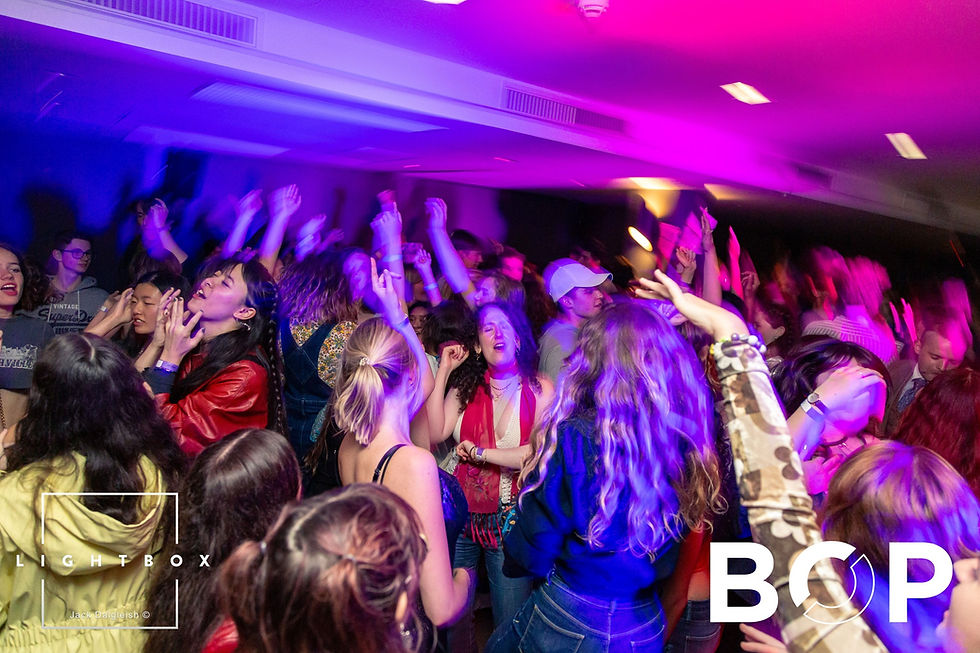What is it with Taylor Swift and St Andrews?
- Christy Forshaw
- Nov 13, 2023
- 4 min read
Updated: May 20, 2024
On Friday 27th October, the day of yet another one of Taylor Swift’s masterful album re-releases, it seemed as if half the town descended on the Union to dance like they were 22 (I’m sorry, but this wouldn’t be an article about Taylor Swift without a couple of puns). It was maybe the busiest, and most definitely the loudest, that I’ve seen the Union all year as students screamed their hearts out, in Main Bar of all places, to non-stop Taylor Swift hits. Yet, this is just the tip of the iceberg for the influence Taylor Swift has on our little university community.
With headlines hitting this week that Taylor Swift has surpassed The Weeknd as the most listened-to artist in the world on Spotify, the question can be raised, what makes St Andrews different? After all, when you have over 100 million monthly listeners, surely it makes sense that Taylor Swift fans can be found everywhere, not just in St Andrews. I would argue, however that the Taylor Swift culture at St Andrews goes beyond this; I’m sure lots of people at this university listen to The Weeknd regularly, but he’s not an ongoing topic of conversation like Taylor Swift is. Taylor Swift is more than just the artist people pop on through their headphones as they walk to class – whether you like her or not, she’s become a cultural talking point in this town.

Source: Jack Dalgliesh for Lightbox St Andrews.
When I say Taylor Swift is a talking point in this town, I don’t just mean that she is what I talk about with my Swiftie friends; if you search up Taylor Swift on St Fessdrews, the watering hole for unfiltered student opinions, you are immediately greeted with post after post debating her recent work, her popularity in this town and the various venues that play her music. On some of the posts, this has led to furious debate surrounding her merit as an artist. To bring in my second Taylor Swift pun of the article – ‘haters gonna hate hate hate’ – the fact that people are debating her on a university forum shows the influence that she has here.
Interestingly, the cinema release of her feature length concert film, Taylor Swift: The Eras Tour, coincided with the petition to save our local St Andrews cinema, the New Picture House, from re-development into a swanky sports bar. Suddenly, the rhetoric in this town surrounding the cinema and Taylor Swift’s film was combined. I heard students saying all over town that they must go see the film in St Andrews to help support the local cinema, an important point of culture in the town, but not one usually discussed on the daily. Whilst the jury is still out on if this helped save the cinema, it’s yet another example of the Taylor Swift effect in this town. When people heard ‘save the cinema’, they also heard ‘go see the Eras Tour film in order to do this’ (and sign the petition, of course, which is still live at this link).
So, if Taylor Swift is a constant talking point in this university town, the question remains – why? A recent and much flaunted study by College Rover found that in the US, ‘Taylor Swift is the top artist for students with high GPAs’.1 Many colleges in the US have even started offering Taylor Swift-themed classes, including Stanford University. That said, to argue that students at St Andrews listen to Taylor Swift because they are high achievers would be arrogant to say the least. I also think that it somewhat conflates cause and effect. I would argue it’s not that students who listen to Taylor Swift are smarter, but rather that what she – at 33 years old – sings about resonates strongly with a young, somewhat disillusioned student body. She might be a millennial, but her lyrics about love resonate with students struggling to find academic success and an adult identity. In Bejeweled she sings: ‘did all the extra credit, then got graded on a curve’. In This is me Trying: ‘fell behind all my classmates, and I ended up here.’ In Mirrorball: ‘I can change everything about me to fit in’ and, to go back even further in her discography, in Never Grow Up she sings: ‘here I am in my new apartment’. Whilst the overall motif of her songs might be relationships, their themes of feeling inadequate and searching for identity on your own intersect with the university experience of moving to a new place, making new friends and studying new things.
To situate this in St Andrews explicitly, St Andrews is an extremely small university town for the UK: three streets, one nightclub and darkness at around 4pm from November until February. To contextualize the climate in St Andrews, last December, following the release of Midnights, I remember listening to Snow on the Beach whilst also experiencing snow on the beach (perhaps not what Taylor and Lana envisioned with the metaphor!). It’s an isolated town, surrounded by fields, in which the university experience is entirely immersive. Some people do go home to their families for the weekend, but it’s tricky to do when the nearest train station is already a 20-minute bus ride away.
As such, it’s a university experience that I would say hinges on community. No large-scale nightlife exists, so students have to make their own, many students are separated from their external support systems, and so have to support each other. This is where Taylor Swift comes in with her songs about feeling alone and confused and, at the same time, songs that people everywhere learn the words to obsessively and scream at the top of their lungs. As Rhiannon Peacock, president of the St Andrews Taylor Swift Society, puts it: her music is ‘cathartic’ in that ‘she unites people and allows them to relate to one another’ (as evidenced when witnessing a whole host of students singing All Too Well at in the Union).

Source: Jack Dalgliesh for Lightbox St Andrews.
This, to me, is the reason that Taylor Swift is so influential at St Andrews particularly. Even if not explicitly, she sings to the St Andrews university experience and, whilst doing this, unites the students as a point of relatability.





Comments